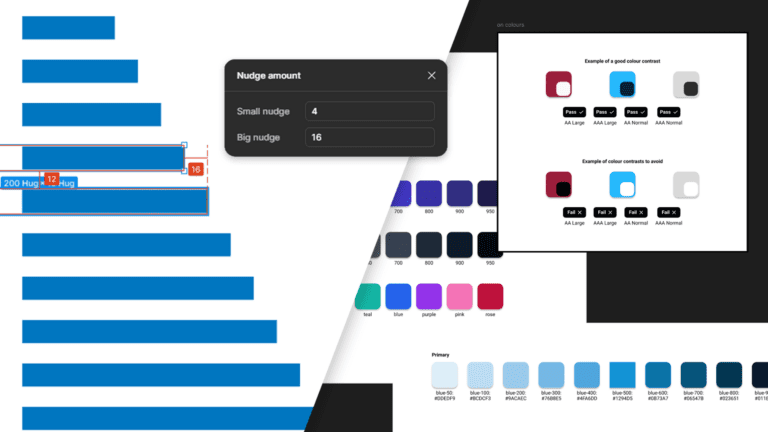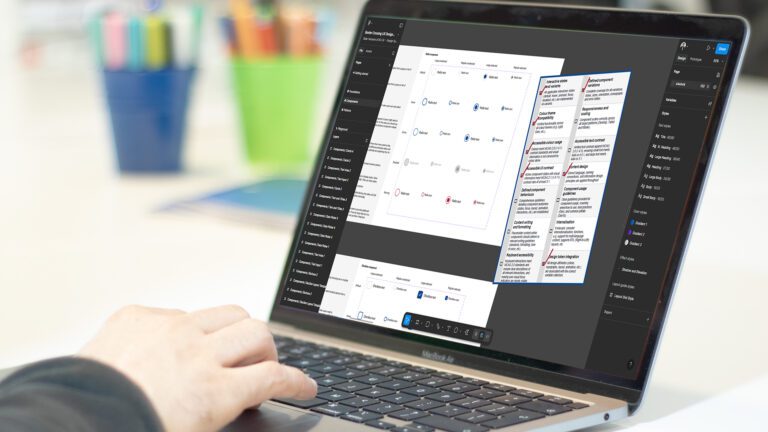Key equipment
Sticky notes
We recommend you purchase sticky notes that are 76mm x 127 mm as these are the perfect size – small enough to encourage brevity, but big enough for participants to generate readable outputs. Also consider using different colours for different steps, e.g. for empathy mapping use yellow for thinking, pink for feeling and green for doing, etc.
Whiteboards and/or flip charts
You can never have enough of these. The more you have, the more you’ll be able to keep the outputs from previous exercises on display instead of covering them up to save space. Always remember to bring your own white board or flip chart pens and cleaning solution!
Pens
We’d always recommend you urge participants to use Sharpies or other permanent pens that offer a thicker and more legible stroke. Avoiding pencils is essential to ensure the writing doesn’t smudge and become difficult to read. Similarly, we avoid using ballpoint pens during group activities to make it easier to see and read from a distance.
Stickers
Stickers are a truly great workshop supply to have – they can help you heat map, vote and decide. Each box will contain more than enough stickers for 1 workshop. So consider providing each participant with a pre-cut set of stickers they can use throughout the day. Consider buying different sizes and colours to use for different exercises.
Clocks, timers, and stopwatches
Keeping to time, and getting through a pre-planned agenda is key to facilitating a successful workshop. Always provide participants with visual cues by using clocks, timers, and stopwatches.
Things to display outputs …
Blue-tac, drawing pins, clothes pegs and string … not necessarily the most high-tech stuff … but so handy when it comes to showcasing outputs effectively.
Refreshments
Timing the delivery of snacks, tea, coffee, and if required additional food, is a great way to break up longer sessions.
But remember to make sure the timing of these are aligned to your agenda. As and when timings for refreshments are dictated to you, make sure you design your agenda around these – to ensure breaks for food and drinks are a positive, not a hindrance.
Keep participant’s energy up by:
Providing
Light and healthy snacks. The longer the session, the greater the need. And it’s always better to get more, than less.
Plenty of water is available throughout the session.
Avoiding
Big meals that take a long time to serve/eat.
Heavy food that is likely to slow people down.
For larger groups (40+ people):
When facilitating larger groups of people, in larger venues, you should also consider:
- Assigning a lead facilitator to lead from the front.
- Ensuring each group either has an additional dedicated facilitator that is focussed on keeping that group on-track and addressing any issues that crop up OR a group leader who has experienced similar processes and is willing to support steering the group.
- Using a microphone and ensuring all groups can see what they need to – as there’s nothing worse than struggling to see slides or hear exercise instructions.
- Using a whistle or other audio cues to alert participants when time is up or drawing to a close.
Equipment checklist
Save time and stress when preparing your next workshop by using this workshop equipment checklist:

Running an online workshop?
Find out more about the tools and stationery we use for online workshops.
Our thoughts
Read the latest thoughts and advice from the team at Border Crossing UX:

Two Figma Design System Tips and Tricks
We all love Figma. But when it comes to designing large and complex systems it can be difficult to maintain consistency and accessibility. In this post, I will cover three practical tips: using Figma’s nudging capabilities; applying ‘on-colour’ values; and introducing colour ramps to foundations. These methods have significantly streamlined my workflow and improved the consistency and accessibility of my designs.

Design checklists – the key for consistency
When creating a design system, you should think about developing and using a design checklist. A design checklist is a group of rules or standards that are tested against. They help ensure any foundation, component, pattern or element meets certain pre-defined criteria. Think of a design checklist as a quality assurance tool – a set of clear standards that all elements in your design system must meet.

Marketing UX when you can’t show or quantify the magic
The UX work we do is often invisible, but its impact is undeniable. Whilst this makes our roles at Border Crossing UX hugely fulfilling on a personal and professional level – it does make marketing our work and the outcomes we have achieved hard. So how can we market our impact when confidentiality is key?